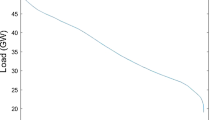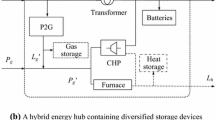Abstract
Germany’s energy transition triggered a rapid and unilateral growth of renewable energy sources (RES) in the electricity sector. With increasing shares of intermittent RES, overcapacities during periods of strong wind and photovoltaic electricity generation occur. In the face of insufficient transmission capacities, due to an inhibited network extension, the electricity generation has to be curtailed. This curtailment of RES leads to economic losses and could be avoided through flexible loads. As an option to cope with those problems, the technologies of power-to-gas (PtG) and power-to-heat (PtH) are presented in this paper. First, the alkaline electrolyzer (AEL), polymer electrolyte membrane electrolyzer (PEMEL), and solid oxide electrolyzer cell (SOEC) are investigated regarding their operational parameters. Second, the electric boiler, electrode heating boiler, and heat pumps are considered. Ultimately, the network-supporting abilities and the potential to provide ancillary services, such as control power, load sequence operation, cold start and part load capability, are compared among one another.
Similar content being viewed by others

References
Berndt H, Hermann M, Kreye H D, Reinisch R, Scherer U, Vanzetta J. Transmission code 2007—network and system rules of the German transmission grid operators. 2007, https://www.bdew.de/internet.nsf/id/A2A0475F2FAE8F44C12578300047C92F/$file/TransmissionCode2007.pdf (in German)
Bundesnetzagentur. The 3th quarterly report on network and system safety measures, 4th quarterly report and overall annual inspection. 2015, http://www.bundesnetzagentur.de/SharedDocs/Downloads/DE/Allgemeines/Bundesnetzagentur/Publikationen/Berichte/2016/Quartalsbericht_Q4_2015.pdf?blob= publicationFile&v = 1 (in German)
Bundesnetzagentur. Quarterly report on network and system security regulations. First quarter 2016. 2016, http://www.bundesnetzagentur.de/SharedDocs/Downloads/DE/Allgemeines/Bundesnetzagentur/Publikationen/Berichte/2016/Quartalsbericht_ Q1_2016.pdf?__blob = publicationFile&v = 2 (in German)
Umweltbundesamt. The potential of controllable loads in an energy supply system with growing share of renewable energy. 2015, https://www.umweltbundesamt.de/sites/default/files/medien/378/publikationen/climate_change_19_2015_potentiale_regelbarer_lasten. pdf (in German)
Götz M, Lefebvre J, Mörs F, McDaniel Koch A, Graf F, Bajohr S, Reimert R, Kolb T. Renewable power-to-gas: a technological and economic review. Renewable Energy, 2016, 85: 1371–1390 (in German)
Kurzweil P, Otto K. Electro-chemical Storages: Supercapacitor, Batteries, Electrolysis Hydrogen, Legal Basics. Wiesbaden: Springer Vieweg, 2015 (in German)
Kurzweil P. Chemistry: Basics, Expanded Knowledge, Applications and Experiments. Wiesbaden: Springer Vieweg, 2015 (in German)
Neumann H. Power-to-gas technology provides primary control power. 2015, http://www.topagrar.com/news/Energie-Energienews-Power-to-Gas-Technik-liefert-Primaerregelenergie-3681471.html (in German)
Agora. Power-to-heat as means for the integration of otherwise curtailed electric power from renewable energy: proposals for action based on the analysis of capability and energy-economic effects. 2014, https://www.agora-energiewende.de/fileadmin/Projekte/2013/power-to heat/Agora_PtH_Langfassung_WEB.pdf (in German)
Müller M. Utilization of heat technology: heat advisor in Hesse. 2015, http://www.ihk-hessen.de/pdf/umwelt_energie/waermestudie- online_10.02.2015.pdf (in German)
Gradmann H, Müller A. Smart conjunction of the power and heat market: the heat pump is the key technology for load management in households. In: Renews Special. Smart conjunction of the power and heat markets, 2012, 59 (in German)
BEE, BWP, HEA, VdZ, ZVEH, ZVEI, ZVSHK. Position paper smart grid: the contribution of heat pumps for load management in smart electricity grids. 2011, http://www.solarserver.de/fileadmin/user_upload/downloads/Positionspapier_SmartGrid_110131_FINAL. PDF (in German)
Liebe A, Wissner M. The flexible consumer–potentials for load shifting in the household sector. 2015, http://www.verbraucherportal-bw.de/site/pbs-bw-new/get/documents/MLR.Verbraucherportal/Dokumente/Dokumente%20pdfs/Verbraucherschutz/Studie%20Energie%20Der_flexible_Verbraucher_WIK_Endbericht.pdf (in German)
DENA. Discussion paper: the significance of catch-up effects regarding the provisioning of control power through flexible loads (Demand Side Management-DSM). 2016, http://www.dsm-bw.de/fileadmin/content/Downloads/Diskussionspapier_DSM_BW_-Nachholeffekte_Regelleistungserbringung_flexible_Lasten.pdf (in German)
Kuehne J. The storage of excess electricity generation through thermal applications: discussions from the AGFW’s point of view. Europe Heat & Power, 2014, 43(6): 40–45 (in German)
Baumann C, Geschermann F, Kilian J, Grote W, Hüttenrauch G, Köppel S, Müllersyring M, Philipp S, Stötzel, Zöllner. Utilization of the power-to-gas technology to disburden the 110-kV power distribution network. 2015, http://www.dvgw-innovation.de/fileadmin/innovation/pdf/g3_03_12_erg.pdf (in German)
Krzikalla N, Achner S, Brühl S. Possibilities to balance fluctuating feed-in from renewable energy. 2013, http://www.bee-ev.de/fileadmin/Publikationen/Studien/Plattform/BEE-Plattform-Systemtransformation_ Ausgleichsmoeglichkeiten.pdf (in German)
Author information
Authors and Affiliations
Corresponding author
Rights and permissions
About this article
Cite this article
Kuprat, M., Bendig, M. & Pfeiffer, K. Possible role of power-to-heat and power-to-gas as flexible loads in German medium voltage networks. Front. Energy 11, 135–145 (2017). https://doi.org/10.1007/s11708-017-0472-8
Received:
Accepted:
Published:
Issue Date:
DOI: https://doi.org/10.1007/s11708-017-0472-8



